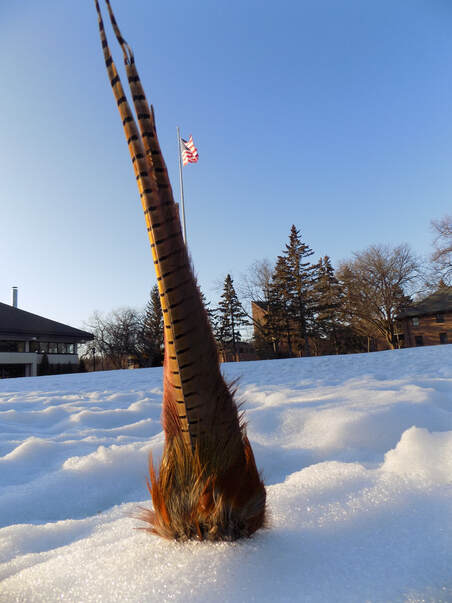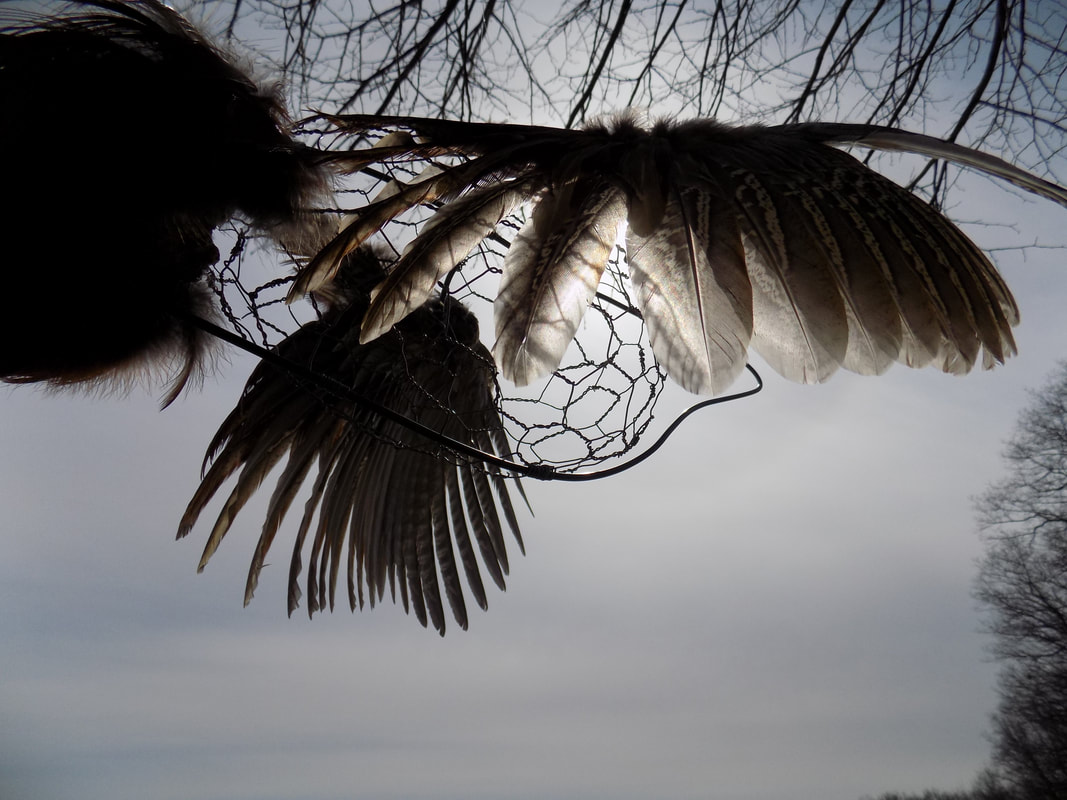The first piece of mail I ever received was a letter from the Rough Grouse Society. My dad is an outdoors-man and he signed me up as a member when I was a baby. He was also a member of Ducks Unlimited and Pheasants Forever and through banquets he acquired quite a collection of wildlife prints and plates that still hang on the walls of the house alongside over 20 animal hides, mounts, and body parts, even a pheasant. Although I was surrounded by hunting, I never wanted to hunt. I had zero desire to shoot a gun and I found dead animal bodies to be highly disturbing.
In my collegiate art practice I began exploring my perceptions of death and the transformation of my favorite animals into food and, to quote Giovanni Aloi, their “cultural afterlife” in taxidermy.
In my collegiate art practice I began exploring my perceptions of death and the transformation of my favorite animals into food and, to quote Giovanni Aloi, their “cultural afterlife” in taxidermy.
Game Birds
Fall 2019, Basswood, Pheasant feathers, Shotgun shell primers, BBs,
|
|
Late one night while thinking about pheasants, I was pondering the word game. This word diminishes an animal to something of use and fun for people. The game pieces are meant to be a play on words as they literally are a game piece. They are covered in feathers of a "game bird". Just as a board game player places their markers on spaces on a board, they are essentially enacting the invasion or colonization of the opponent’s territory on the board. I see the pheasants’ presence in America to be a metaphor for this. Pheasants, have been used as another way to colonize and assimilate the American continent to suit the needs and desires of the settlers. Pheasants had no say in the matter; they are merely passive pawns doing their best to survive in a new landscape. To me, seeing a pheasant in a landscape is a geographic marker. They are reminders of the complicated journey of this species across continents. I wonder if pheasants know they are not “from” here. Or if they even know where they are from.
|
State Bird

Although pheasants are not native to the American Continents, yet they are not considered invasive. The first successful introduction of the Ring-neck Pheasant from China to the Oregon, U.S was in the early 1880s facilitated by Owen and Gertrude Denny. They were brought over in hopes of building a sustainable population for hunting them in the States. Ever since, organizations and campaigns have been supporting this introduced animal to thrive in the American continent by protecting their habitats and populations. The Ringneck Pheasant has received a highly welcoming response by people unlike the response towards the Asian Carp, and even Pigeons. At a local climate strike I attended, declining pheasant populations were even a topic of discussion. This leads me to question how we decide what is invasive and what is not. What is worthy of protection and what should be removed at all costs. As stated by Crystal Fortwrangler in Untangling Introduced and Invasive Animals (2013), “President Clinton's 1999 Executive Order 13112 defines "invasive species" as, "an alien species whose introduction does or is likely to cause economic or environmental harm or harm to human health.” Notice the emphasis on the economy and the health of humans. The defining of introduced versus invasive is as a result of human bias. This is likely why pheasants do not receive the same villainous title of “invasive”. They benefit the huge pheasant hunting economy especially in South Dakota. Pheasants are political.
Bird Cage
Crystal Fortwrangler in Untangling Introduced and Invasive Animals, discussed at length the strikingly parallel rhetoric directed towards invasive and introduced species and human migrants. The rhetoric used in both of these cases is often negative and calls to the same evidence of (rapid spread, overpopulation, degradation of an ecosystem, oppression of native organisms, etc.) when arguing against the presence and spread of these beings in a landscape. This sculpture titled "Bird Cage" is a metaphor for contemporary immigration in the United States where there are more barriers and in many cases, physical cages, preventing people from movement across land.
Bird Cage is also intended to evoke the manner in which the pheasant was introduced to America- via a cage. The wings are outstretched because although the pheasant has been caged the pheasant still traveled great distances. Rather, because of the cage. Birds are often symbols of freedom because of their ability to soar above borders, but the pheasant is not migratory and can not fly great distances. It is through the help of humans that they have been granted long distance travel. I see the pheasant as an icon for aid and integration of refugees and migrants.
The metal armature and the reassembly of the bird also is a link to trophy hunting and taxidermy where animal bodies are reconstructed in order to reproduce the animal as an object for collecting, preserving the memory of the hunt, glorifying the hunter, and testifying to their lethality.
Bird Cage is also intended to evoke the manner in which the pheasant was introduced to America- via a cage. The wings are outstretched because although the pheasant has been caged the pheasant still traveled great distances. Rather, because of the cage. Birds are often symbols of freedom because of their ability to soar above borders, but the pheasant is not migratory and can not fly great distances. It is through the help of humans that they have been granted long distance travel. I see the pheasant as an icon for aid and integration of refugees and migrants.
The metal armature and the reassembly of the bird also is a link to trophy hunting and taxidermy where animal bodies are reconstructed in order to reproduce the animal as an object for collecting, preserving the memory of the hunt, glorifying the hunter, and testifying to their lethality.
References:
Aloi, Giovanni. "A Natural History Panopticon: Power, Representation, and Animal Objectification." In Speculative Taxidermy: Natural History, Animal Surfaces, and Art in the Anthropocene, 71-102. New York:
Columbia University Press, 2018. Accessed April 26, 2020. doi:10.7312/aloi18070.7.
Aloi, Giovanni. "Dioramas: Power, Realism, and Decorum." In Speculative Taxidermy: Natural History, Animal Surfaces, and Art in the Anthropocene, 103-35. New York: Columbia University Press, 2018. Accessed
April 26, 2020. doi:10.7312/aloi18070.8.
Aloi, Giovanni. "Reconfiguring Animal Skins: Fragmented Histories and Manipulated Surfaces." In Speculative Taxidermy: Natural History, Animal Surfaces, and Art in the Anthropocene, 43-70. New York: Columbia
University Press, 2018. Accessed April 26, 2020. doi:10.7312/aloi18070.6.
Fortwangler, Crystal. "Untangling Introduced and Invasive Animals." Environment & Society 4 (2013): 41-59. Accessed April 29, 2020. www.jstor.org/stable/43297036.
Holmgren, Virginia C. "Chinese Pheasants, Oregon Pioneers." Oregon Historical Quarterly 65, no. 3 (1964): 229-62. Accessed May 6, 2020. www.jstor.org/stable/20612804.
Aloi, Giovanni. "A Natural History Panopticon: Power, Representation, and Animal Objectification." In Speculative Taxidermy: Natural History, Animal Surfaces, and Art in the Anthropocene, 71-102. New York:
Columbia University Press, 2018. Accessed April 26, 2020. doi:10.7312/aloi18070.7.
Aloi, Giovanni. "Dioramas: Power, Realism, and Decorum." In Speculative Taxidermy: Natural History, Animal Surfaces, and Art in the Anthropocene, 103-35. New York: Columbia University Press, 2018. Accessed
April 26, 2020. doi:10.7312/aloi18070.8.
Aloi, Giovanni. "Reconfiguring Animal Skins: Fragmented Histories and Manipulated Surfaces." In Speculative Taxidermy: Natural History, Animal Surfaces, and Art in the Anthropocene, 43-70. New York: Columbia
University Press, 2018. Accessed April 26, 2020. doi:10.7312/aloi18070.6.
Fortwangler, Crystal. "Untangling Introduced and Invasive Animals." Environment & Society 4 (2013): 41-59. Accessed April 29, 2020. www.jstor.org/stable/43297036.
Holmgren, Virginia C. "Chinese Pheasants, Oregon Pioneers." Oregon Historical Quarterly 65, no. 3 (1964): 229-62. Accessed May 6, 2020. www.jstor.org/stable/20612804.

